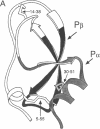Abstract
We have shown previously that during the oxidative folding of bovine pancreatic trypsin inhibitor only intermediates with native disulfide bonds are well populated. Nevertheless, these studies also confirmed the earlier conclusion [Creighton, T. E. (1977) J. Mol. Biol. 113, 275-293] that the rate-limiting transition in the kinetically preferred route for folding involves intramolecular disulfide bond rearrangements. Consequently, intermediates with nonnative disulfide bonds must form transiently during folding. Two specific nonnative species, denoted [30-51; 5-14] and [30-51; 5-38], in which numbers indicate residues participating in a disulfide bond, can be detected at low levels in kinetic folding experiments with bovine pancreatic trypsin inhibitor. By working with purified reversibly trapped intermediates, the role of these two nonnative species has been examined directly. These species are found to be in relatively rapid exchange with each other and with an initially formed native two-disulfide intermediate [30-51; 14-38]. Thus, the low abundance of the two nonnative species detected in kinetic folding experiments reflects primarily their low thermodynamic stability as compared to this native intermediate. To a small extent, these nonnative species form the productive native intermediate [30-51; 5-55], which is the immediate precursor to the native protein. However, an equal amount of [5-55; 14-38], a nonproductive dead-end intermediate, is also produced. Thus, the nonnative species detected during the folding of bovine pancreatic trypsin inhibitor are not committed to forming the productive native intermediate, nor do they serve to direct folding specifically toward a productive route.
Full text
PDF
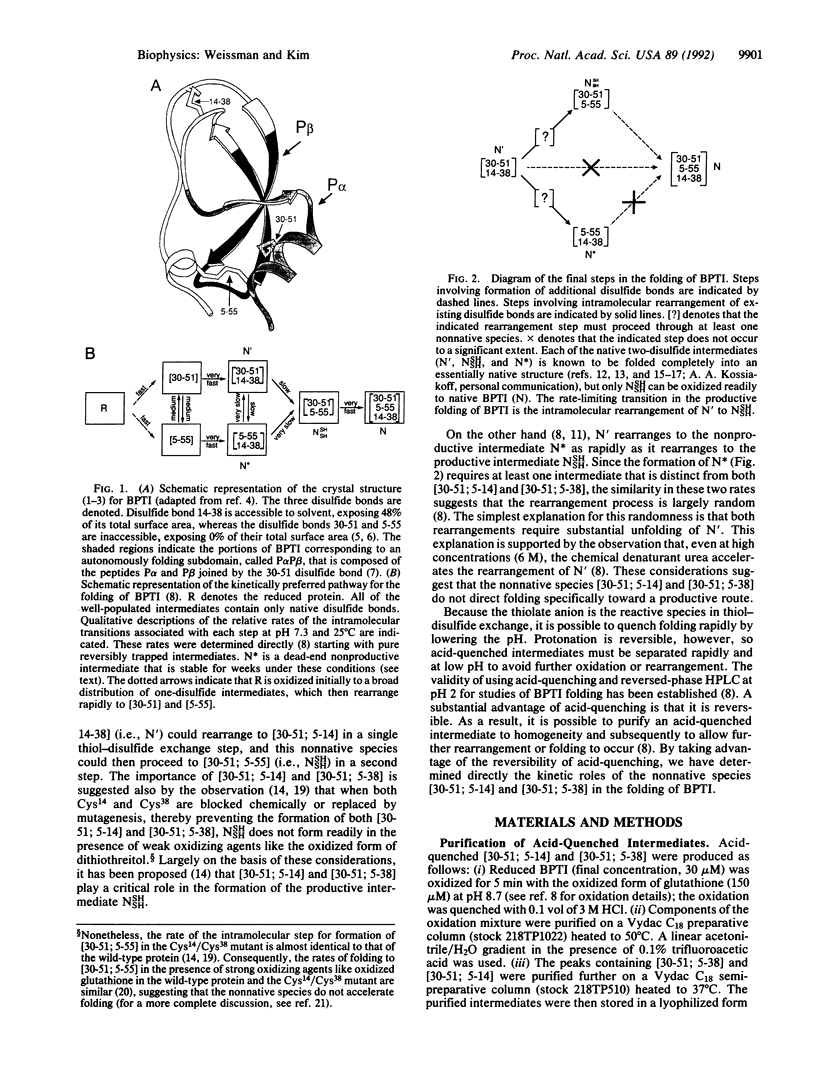
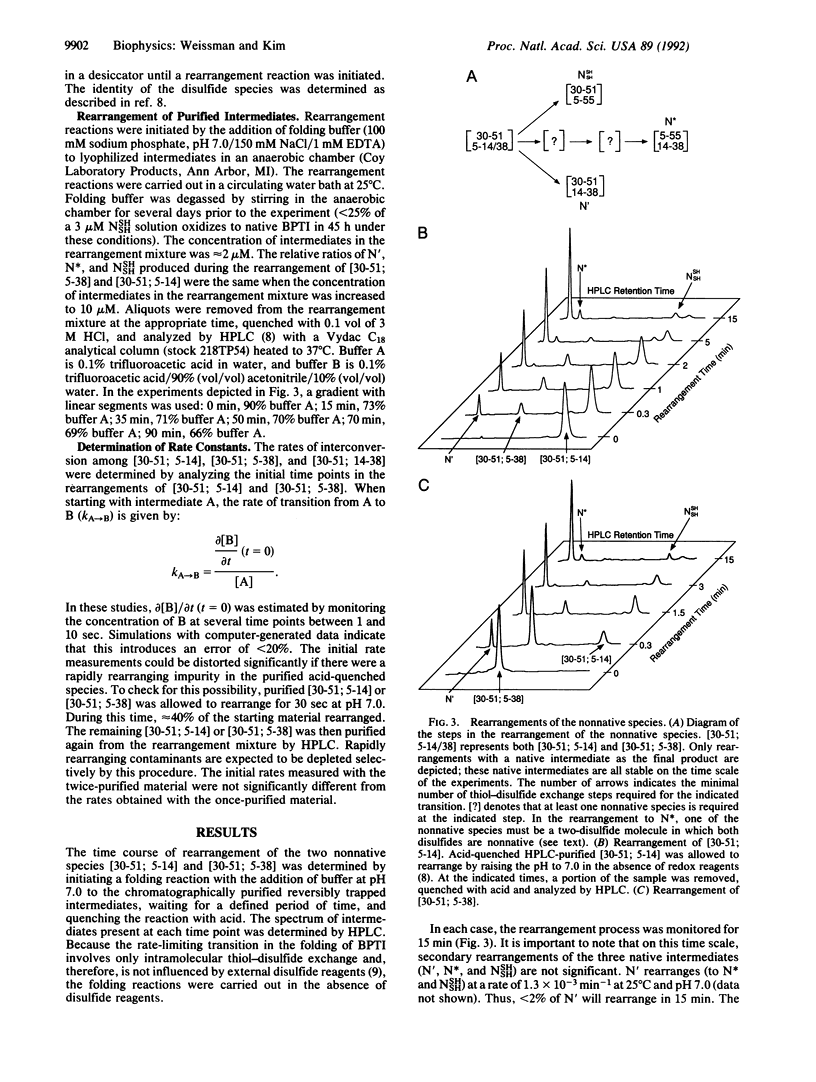
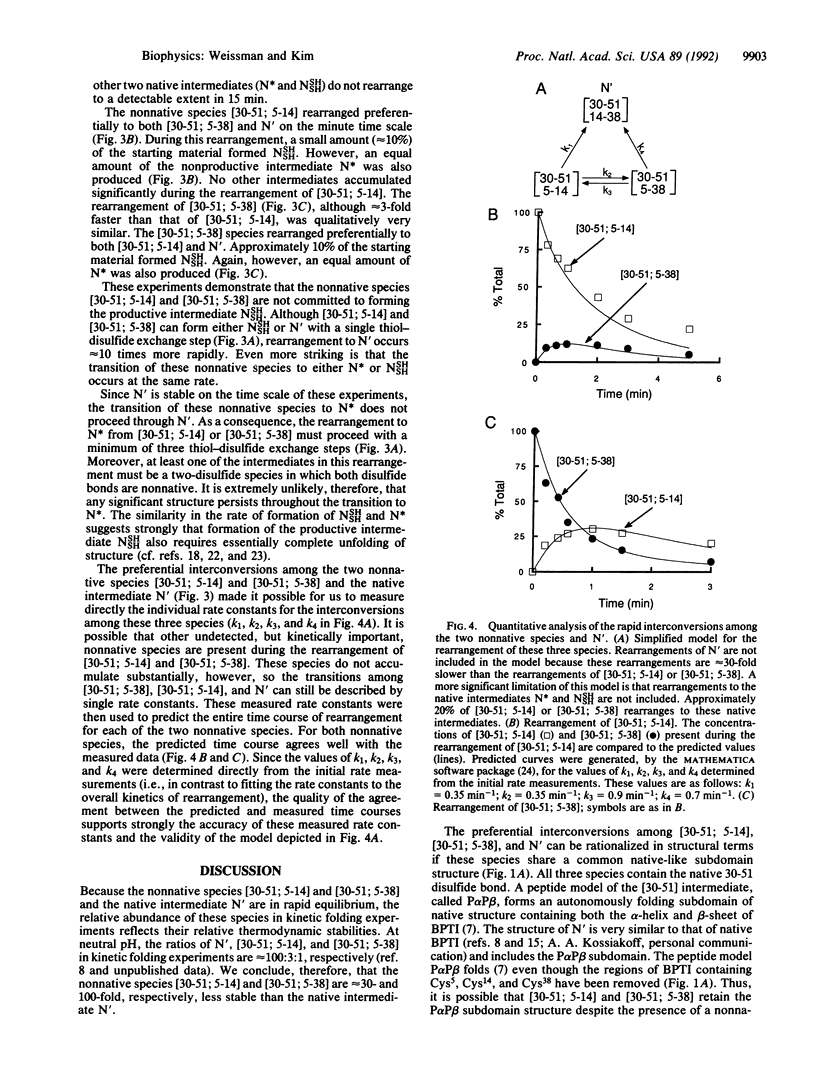
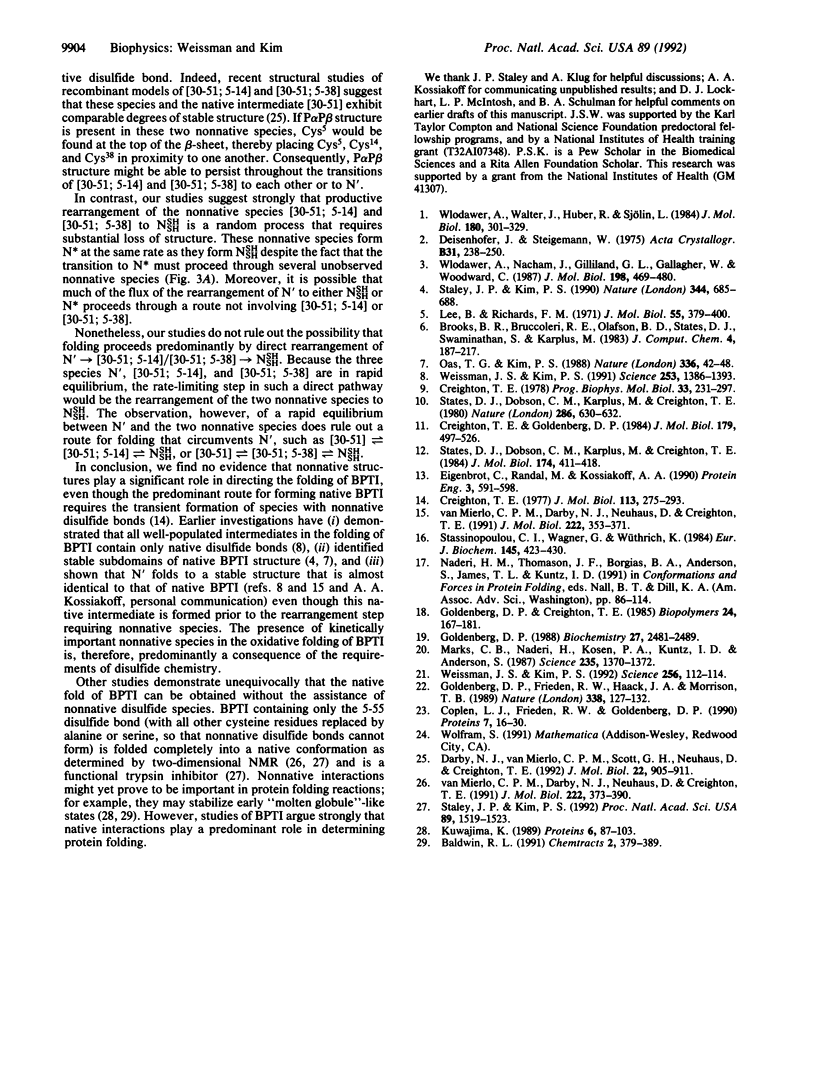
Images in this article
Selected References
These references are in PubMed. This may not be the complete list of references from this article.
- Coplen L. J., Frieden R. W., Goldenberg D. P. A genetic screen to identify variants of bovine pancreatic trypsin inhibitor with altered folding energetics. Proteins. 1990;7(1):16–31. doi: 10.1002/prot.340070103. [DOI] [PubMed] [Google Scholar]
- Creighton T. E. Conformational restrictions on the pathway of folding and unfolding of the pancreatic trypsin inhibitor. J Mol Biol. 1977 Jun 25;113(2):275–293. doi: 10.1016/0022-2836(77)90142-5. [DOI] [PubMed] [Google Scholar]
- Creighton T. E. Experimental studies of protein folding and unfolding. Prog Biophys Mol Biol. 1978;33(3):231–297. doi: 10.1016/0079-6107(79)90030-0. [DOI] [PubMed] [Google Scholar]
- Creighton T. E., Goldenberg D. P. Kinetic role of a meta-stable native-like two-disulphide species in the folding transition of bovine pancreatic trypsin inhibitor. J Mol Biol. 1984 Nov 5;179(3):497–526. doi: 10.1016/0022-2836(84)90077-9. [DOI] [PubMed] [Google Scholar]
- Darby N. J., van Mierlo C. P., Scott G. H., Neuhaus D., Creighton T. E. Kinetic roles and conformational properties of the non-native two-disulphide intermediates in the refolding of bovine pancreatic trypsin inhibitor. J Mol Biol. 1992 Apr 20;224(4):905–911. doi: 10.1016/0022-2836(92)90458-v. [DOI] [PubMed] [Google Scholar]
- Eigenbrot C., Randal M., Kossiakoff A. A. Structural effects induced by removal of a disulfide-bridge: the X-ray structure of the C30A/C51A mutant of basic pancreatic trypsin inhibitor at 1.6 A. Protein Eng. 1990 Jul;3(7):591–598. doi: 10.1093/protein/3.7.591. [DOI] [PubMed] [Google Scholar]
- Goldenberg D. P., Creighton T. E. Energetics of protein structure and folding. Biopolymers. 1985 Jan;24(1):167–182. doi: 10.1002/bip.360240114. [DOI] [PubMed] [Google Scholar]
- Goldenberg D. P., Frieden R. W., Haack J. A., Morrison T. B. Mutational analysis of a protein-folding pathway. Nature. 1989 Mar 9;338(6211):127–132. doi: 10.1038/338127a0. [DOI] [PubMed] [Google Scholar]
- Goldenberg D. P. Kinetic analysis of the folding and unfolding of a mutant form of bovine pancreatic trypsin inhibitor lacking the cysteine-14 and -38 thiols. Biochemistry. 1988 Apr 5;27(7):2481–2489. doi: 10.1021/bi00407a034. [DOI] [PubMed] [Google Scholar]
- Kuwajima K. The molten globule state as a clue for understanding the folding and cooperativity of globular-protein structure. Proteins. 1989;6(2):87–103. doi: 10.1002/prot.340060202. [DOI] [PubMed] [Google Scholar]
- Lee B., Richards F. M. The interpretation of protein structures: estimation of static accessibility. J Mol Biol. 1971 Feb 14;55(3):379–400. doi: 10.1016/0022-2836(71)90324-x. [DOI] [PubMed] [Google Scholar]
- Marks C. B., Naderi H., Kosen P. A., Kuntz I. D., Anderson S. Mutants of bovine pancreatic trypsin inhibitor lacking cysteines 14 and 38 can fold properly. Science. 1987 Mar 13;235(4794):1370–1373. doi: 10.1126/science.2435002. [DOI] [PubMed] [Google Scholar]
- Oas T. G., Kim P. S. A peptide model of a protein folding intermediate. Nature. 1988 Nov 3;336(6194):42–48. doi: 10.1038/336042a0. [DOI] [PubMed] [Google Scholar]
- Staley J. P., Kim P. S. Complete folding of bovine pancreatic trypsin inhibitor with only a single disulfide bond. Proc Natl Acad Sci U S A. 1992 Mar 1;89(5):1519–1523. doi: 10.1073/pnas.89.5.1519. [DOI] [PMC free article] [PubMed] [Google Scholar]
- Staley J. P., Kim P. S. Role of a subdomain in the folding of bovine pancreatic trypsin inhibitor. Nature. 1990 Apr 12;344(6267):685–688. doi: 10.1038/344685a0. [DOI] [PubMed] [Google Scholar]
- Stassinopoulou C. I., Wagner G., Wüthrich K. Two-dimensional 1H NMR of two chemically modified analogs of the basic pancreatic trypsin inhibitor. Sequence-specific resonance assignments and sequence location of conformation changes relative to the native protein. Eur J Biochem. 1984 Dec 3;145(2):423–430. doi: 10.1111/j.1432-1033.1984.tb08571.x. [DOI] [PubMed] [Google Scholar]
- States D. J., Dobson C. M., Karplus M. A new two-disulphide intermediate in the refolding of reduced bovine pancreatic trypsin inhibitor. J Mol Biol. 1984 Apr 5;174(2):411–418. doi: 10.1016/0022-2836(84)90345-0. [DOI] [PubMed] [Google Scholar]
- States D. J., Dobson C. M., Karplus M., Creighton T. E. A conformational isomer of bovine pancreatic trypsin inhibitor protein produced by refolding. Nature. 1980 Aug 7;286(5773):630–632. doi: 10.1038/286630a0. [DOI] [PubMed] [Google Scholar]
- Weissman J. S., Kim P. S. Reexamination of the folding of BPTI: predominance of native intermediates. Science. 1991 Sep 20;253(5026):1386–1393. doi: 10.1126/science.1716783. [DOI] [PubMed] [Google Scholar]
- Weissman J. S., Kim P. S. Response. Science. 1992 Apr 3;256(5053):112–114. doi: 10.1126/science.256.5053.112. [DOI] [PubMed] [Google Scholar]
- Wlodawer A., Nachman J., Gilliland G. L., Gallagher W., Woodward C. Structure of form III crystals of bovine pancreatic trypsin inhibitor. J Mol Biol. 1987 Dec 5;198(3):469–480. doi: 10.1016/0022-2836(87)90294-4. [DOI] [PubMed] [Google Scholar]
- Wlodawer A., Walter J., Huber R., Sjölin L. Structure of bovine pancreatic trypsin inhibitor. Results of joint neutron and X-ray refinement of crystal form II. J Mol Biol. 1984 Dec 5;180(2):301–329. doi: 10.1016/s0022-2836(84)80006-6. [DOI] [PubMed] [Google Scholar]
- van Mierlo C. P., Darby N. J., Neuhaus D., Creighton T. E. (14-38, 30-51) double-disulphide intermediate in folding of bovine pancreatic trypsin inhibitor: a two-dimensional 1H nuclear magnetic resonance study. J Mol Biol. 1991 Nov 20;222(2):353–371. doi: 10.1016/0022-2836(91)90216-s. [DOI] [PubMed] [Google Scholar]
- van Mierlo C. P., Darby N. J., Neuhaus D., Creighton T. E. Two-dimensional 1H nuclear magnetic resonance study of the (5-55) single-disulphide folding intermediate of bovine pancreatic trypsin inhibitor. J Mol Biol. 1991 Nov 20;222(2):373–390. doi: 10.1016/0022-2836(91)90217-t. [DOI] [PubMed] [Google Scholar]



